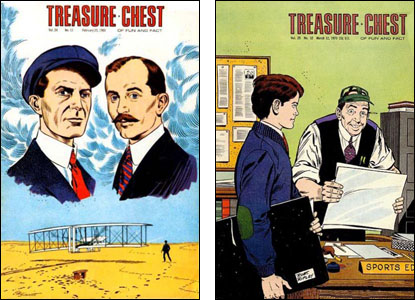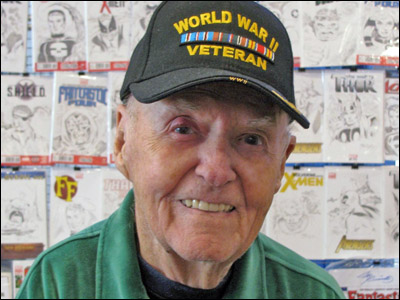Curtis Burga read this item, then sent me this…
In your article, you stated that Joe Sinnott was not working for Marvel when Avengers #4 was created. However, a year earlier, Sinnott's work was very much apparent in Fantastic Four #5.
Was Sinnott freelance? Or had he worked at Marvel and then quit? I ask because he was probably my favorite inker on many artists (he really made George Perez's artwork shine!). His work on F.F. #5 is (ahem) fantastic.
Joe Sinnott did excellent work. He was the kind of artist that editors feel blessed to have available to them. He met every deadline on every job and there were times when someone else did less-than-wonderful or less-than-complete pencil art and Stan Lee could say "Joe will save it." Sinnott was also one of the nicest men you could ever meet.
But I'm not sure he ever qualified as an employee at Marvel in any legal sense of the word. Folks are very loose with the language about this kind of thing and there have been times when comic book companies — as well as other enterprises — found it beneficial to keep things ambiguous. Joe was a freelancer most of the time, probably all of the time. He did not report to the office each day or any days for work. He worked at home, many miles away, and only visited the Marvel offices briefly every eight or nine years, if that often.
A lot of folks are confused by this because Stan Lee kept referring to "The Marvel Bullpen," suggesting that all its writers and artists worked in some sort of grouping not unlike a baseball team. While Marvel did have a few artists who worked in the office, something like 90%+ of the people who wrote and/or drew and/or lettered and/or colored comic books worked at home or in their own offices or studios. Much of the time, saying "he works for Marvel" really meant he did freelance work for Marvel, perhaps among other clients. That was certainly the case with Sinnott during the period you mention.
Around the period when Fantastic Four #5 was done, Joe was freelancing for several markets, not all of which were comic books. For comics, he worked in the sixties for Dell and did a lot for a comic book called Treasure Chest of Fun & Fact that was produced — at times, twice a month — for the "parochial" market, meaning Catholic schools and gift shops. Here are two issues that featured Joe's art on the cover…

He also inked for Archie and ghost-penciled for certain friends. And the following is kind of a theory on my part but I'll bet it's not far from the truth. Fantastic Four #1 and #2 were inked by George Klein, who at the same time was freelancing for DC Comics and sometimes other firms. Then he suddenly stopped working for Stan Lee and it's pretty easy to guess why.
A gentleman named Stan Kaye had been inking most of Curt Swan's art for DC and for a few other artists, as well. Then in 1962, he stopped doing that and, according to online sources, moved to Racine, Wisconsin to work in his father-in-law's manufacturing business. Most of his assignments thereafter went to Klein, who of course grabbed them. DC paid way better than Marvel and the company was on much firmer ground. When Klein inked those two Fantastic Four issues, there were still rumors around that Marvel would go out of business any day, whereas inking Swan on Superman might have been the most secure job in comics.
The next two issues of F.F. were inked by Sol Brodsky, who was functioning as Production Manager at Marvel then, though when I asked him when he officially got that title, he wasn't sure. Basically, he came in a few days per week to handle the artistic editorial chores that were beyond Stan's limited abilities in that area. And here's an example of how it's often hard to ascertain whether someone actually works for a company as opposed to being a freelance contributor. Sol was paid by the day when he did that work. If he inked a cover or a story during one of those paid workdays, he probably did that as an employee. If he did that inking at home — or even in the office on a day when he wasn't being paid for that day — it was almost certainly freelance work. And during this period, he also did freelance art or production work for other outfits.
See the problem? And like I said, sometimes publishers liked keeping it ambiguous. At times when it might be financially beneficial for your publisher to say they had numerous employees, you might be called an employee. But if you asked about things like sick pay or paid vacations or severance pay or other benefits that employees received, they would of course say, "You don't get those. You're not an employee. You're an Independent Contractor!" Of such fuzziness are lawsuits born.

Brodsky was busy and, as I mentioned in that previous ASKme, a slow inker…so they needed someone to ink Fantastic Four #5. So Stan (or perhaps Sol) called Joe and at that moment, Joe had time to fit the job into his work schedule. After he did that, he started inking F.F. #6 but he wasn't even a day into it when other assignments came in and he realized he wouldn't be able to make all his deadlines. So he called Stan (or Sol) and arranged to send the issue back. #6 was finished by Dick Ayers who did around 99% of it but if you look real careful, you can find the 1% or so that Joe inked on the first few pages.
Thereafter, Joe was offered other work by Marvel and he said yes to a few things — he penciled and inked five early Thor stories, for instance — but no to others. As a freelancer, you sometimes have to pick and choose based on factors like how much you think you'll enjoy a given assignment and how long it will take you and how much it pays. As mentioned, Marvel paid very low rates to its inkers. Joe told me that inking a page of a Jack Kirby super-hero story took twice as long as inking a page of Archie by someone like Dan DeCarlo but they paid about the same.
In 1965, Marvel Publisher Martin Goodman was unhappy with the art for Fantastic Four Annual #3. According to Brodsky, that made Goodman persuadable to raise the budget for artwork on the comics. The inking rate only went up a couple of bucks per page but it was enough to get Sinnott to begin inking again for Marvel. A year or two later when the rate was raised again, he cut back more on his work for other outfits.
He was so valuable that at some point, they gave him some sort of freelance contract that made him exclusive to Marvel. I suspect you'd have to read it to say that he worked for Marvel, rather than that he was self-employed and freelanced for Marvel…but there's no reason for us to make that distinction. When I said he wasn't working for Marvel when Avengers #4 needed inking, I meant that he was unavailable to do freelance work for them…and at other times, he was. It was not a matter of him quitting a job.
